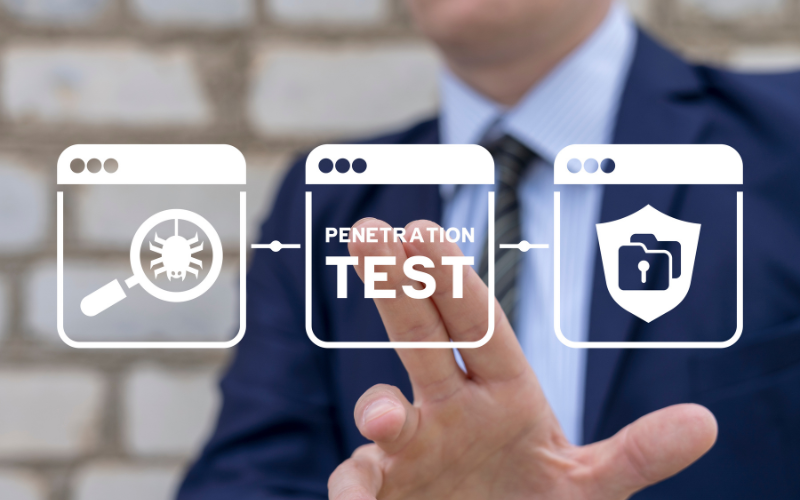Penetration testing for first-timers: how to know if you need one
by Aaron Flack on Oct 10, 2025

Most first Penetration Testing projects are bought for the wrong reason. A client asks for a certificate, cyber insurance tightens its wording, or a board member reads about an incident and wants reassurance by quarter-end. Penetration Testing is most effective when it is risk-driven and well-scoped. It is not a cure, not a compliance badge, and not a shortcut to security maturity. It is an assurance activity that validates how real attackers could move through your environment, then proves whether your controls stop them.
Leaders need a simple path to a thoughtful first engagement. This article explains what Penetration Testing is, when it is genuinely required, when a different approach is the better move, what the work involves, and how to turn findings into measurable risk reduction.
What Penetration Testing is, and what it is not
Penetration Testing is a controlled attack conducted by skilled professionals who act like real adversaries. The aim is precise: identify viable attack paths that matter to the business, demonstrate impact, and provide evidence that a team can fix. Strong testers chain issues to mirror real behaviour —for example, weak external hygiene that leads to single sign-on abuse, which in turn leads to data exfiltration.
Penetration Testing is not a vulnerability scan. Scans list weaknesses at scale, Penetration Testing validates and exploits the ones that matter. It is not Cyber Essentials Plus, not a generic health check, and not a one-and-done exercise. It is a snapshot of risk at a point in time, useful only if the business fixes what is found and retests critical paths.
Do you actually need one now?
-
Compliance or customer pressure
-
PCI cardholder data in scope: plan for Penetration Testing on a defined cadence and after significant change.
-
Cyber Essentials Plus target: complete CE Plus first, then consider focused Penetration Testing where residual risk remains.
-
ISO 27001 certification or surveillance: run risk-led testing that could include Penetration Testing, but the standard does not mandate it in every case.
-
NIS or NIS2 operator duties: take a risk-based approach, use Penetration Testing where impact justifies it.
-
-
Recent change or new exposure
-
Internet-facing change —for example, a new web application, a major Microsoft 365 configuration shift, new remote access, or a cloud network redesign —test the exposed surface and identity paths.
-
Internal change only —for example, Active Directory hardening, segmentation, or privileged access overhaul —start with configuration and build reviews, then targeted internal Penetration Testing if controls are unproven.
-
-
Incident or insurance driver
-
Post-incident validation: run scoped Penetration Testing to confirm the attack path is closed, then implement continuous hygiene checks.
-
Insurance requirement: confirm policy wording, many carriers accept structured testing evidence, not only Penetration Testing.
-
-
First security step with little visibility
-
Start with a vulnerability assessment and a review of Microsoft 365 or Azure secure configuration. Add a compact external Penetration Test for the highest risk assets. Spend on fixes before broad testing.
-
If there is doubt between two routes, prioritise work that quickly improves control quality, for example, hardening, identity hygiene, and patching exploitable services. Book Penetration Testing once those basics are in place; otherwise, the spend proves what is already known.
Framework pressure decoded: ISO 27001, Cyber Essentials Plus, PCI DSS, NIS and NIS2.
-
ISO 27001
The standard expects technical vulnerabilities to be managed and for security testing to be risk-driven. It does not instruct every organisation to run a complete Penetration Test every year. Penetration Testing is a valid method to demonstrate control effectiveness when the risk justifies it. -
Cyber Essentials Plus
CE Plus is a hands-on audit of five baseline control areas. It includes internal and external tests carried out by an assessor. It is not Penetration Testing and does not attempt to chain findings or simulate targeted attack paths. -
PCI DSS
Payment environments require internal and external Penetration Testing on a regular cadence and after significant changes. Segmentation must be tested if used to reduce the scope. Retesting is expected to validate fixes. -
NIS and NIS2
Operators of essential services must implement appropriate and proportionate measures. Penetration Testing can be part of that assurance portfolio, driven by impact and risk rather than used by default.
Scope it right the first time.
A sharp first engagement avoids wasted spend and keeps results actionable.
People and decision makers
Name an executive sponsor, a technical owner, and a resolver group lead. Agree approval paths for out-of-hours testing and for testing credentials. Decide who signs off on scope changes.
Systems in scope
List internet-facing assets, crown jewel data stores, identity systems, third-party dependencies, and anything new since the last architectural change. Clarify staging versus production. If production must be tested, define safe performance windows.
Boundaries and rules of engagement
-
What testers may and may not do, for example, social engineering, cloud tenant changes, and MFA fatigue testing.
-
Hours of operation, safe words, and incident contacts.
-
Data handling and evidence capture.
-
Exploitation limits, for example, no destructive payloads and no exfiltration of production data beyond proof.
Success criteria
-
Business questions to answer, for example, can an attacker pivot from a supplier portal to finance systems, or can a compromised Microsoft 365 mailbox lead to widespread access?
-
Required artefacts, for example, an executive summary, technical detail with evidence, a prioritised fix plan, and a retest.
What actually happens during testing
Reconnaissance and mapping
Testers enumerate assets, identities, and third-party components. Expect discoveries of unknown items, such as forgotten subdomains or legacy VPN endpoints.
Initial access and chaining
Findings are combined into attack paths —for example, weak TLS on a legacy service that allows credential capture, which then enables legacy SMB and lateral movement.
Privilege escalation and impact
Where safe and agreed, testers show business impact. The best reports show the path, the evidence, and the fix in clear language that the resolvers can follow.
Daily communication
Expect short daily updates with blocker flags. If a critical issue appears, the team will escalate immediately so the organisation can mitigate before the final report.
Reporting and readout
Two useful outputs add real value. First, a board-ready summary that explains risk in business terms. Second, a technical pack that maps each finding to a straightforward remediation task with owners and complexity.
Retest
Build retest into the statement of work. Without a retest, leaders cannot prove that critical weaknesses are actually fixed.
Turn findings into fixes.
Without disciplined follow-through, Penetration Testing becomes expensive theatre. Treat the report as a worklist.
-
Triage: tag each finding by exploitability, impact, and blast radius. Fix anything that unlocks identity abuse or lateral movement first.
-
Ownership: assign a named resolver for each item with a time-bound target.
-
Remediation design: prefer control improvements that prevent entire classes of issues, such as conditional access, phishing-resistant MFA, privileged access workstations, and automated patch governance.
-
Validation: run the retest and capture evidence.
-
Metrics: report the mean time to remediate for critical items, the number of attack paths closed, and the residual risk. Share results with the board and, if relevant, with insurance.
What to buy for a first engagement
Prioritise focus and quality.
-
External infrastructure Penetration Testing for internet-facing assets and identity paths.
-
Targeted web application Penetration Testing for any app that processes sensitive data or revenue.
-
Microsoft 365 and Azure attack path review to validate identity controls, conditional access, and privilege boundaries.
-
Optional internal Penetration Testing if lateral movement risk is suspected.
-
Retest included for critical findings.
-
Executive and technical reporting designed for action.
A brief note on keywords for findability. Include “pentest” once or twice for search alignment, for example, in an H2 or in the CTA paragraph. The primary term across the page remains Penetration Testing to avoid any potential partner copyright issues.
Why Conosco
Conosco is a UK-only, security-first technology partner. The testing team is CREST certified and delivers from the UK. Reports are written for both executives and engineers, recommendations are practical, and a retest is available to validate fixes. Testing aligns to ISO, Cyber Essentials Plus, PCI, and NIS expectations. There is no forced upsell, only clear evidence and a path to risk reduction.
A compact framework cheat sheet
-
ISO 27001: risk-driven testing. Penetration Testing is used where risk justifies it.
-
Cyber Essentials Plus: audit against baseline controls, not Penetration Testing.
-
PCI DSS: Penetration Testing required on a cadence and after significant change, plus segmentation testing where used.
-
NIS and NIS2: proportionate security measures, test where impact warrants.
First-time Penetration Testing Scoping Checklist
Use this to brief stakeholders and speed up procurement.
-
Business objective, for example, customer assurance for a new platform, PCI scope validation, or post-incident confidence.
-
In scope assets with owners, including external hosts, web apps, cloud tenants, and third-party dependencies.
-
Change calendar and blackout periods.
-
Rules of engagement, including social engineering, time of day, exploitation limits, and evidence handling.
-
Credentials and test accounts, including MFA arrangements.
-
Contacts for live issues and emergency pauses.
-
Required outputs, for example, executive summary, technical detail, fix plan, and retest.
-
Success measures, for example, attack paths closed, time to remediate, and residual risk.
Ready to move
Book a Penetration Testing scoping call. Conosco will confirm whether Penetration Testing is the right move this quarter, shape a focused scope, and set you up to fix and validate without delay. For search alignment, include “pentest scoping call” once here.
You might be interested in our portfolio of solutions
You May Also Like
These Related Stories

Data Silos: What Are They and How Do You Fix Them?

Public Sector Data Management: 6 Lessons from the Track and Trace Blunder
Written by Jon Taylor, Principal Consultant at Conosco The public sector often comes under close scrutiny, but in the mi …

8 Benefits Of Digital Transformation For Your Employees (2021)
Written by Noel Thompson, Director of South Africa Over the past year, we’ve seen the rapid development and installation …
